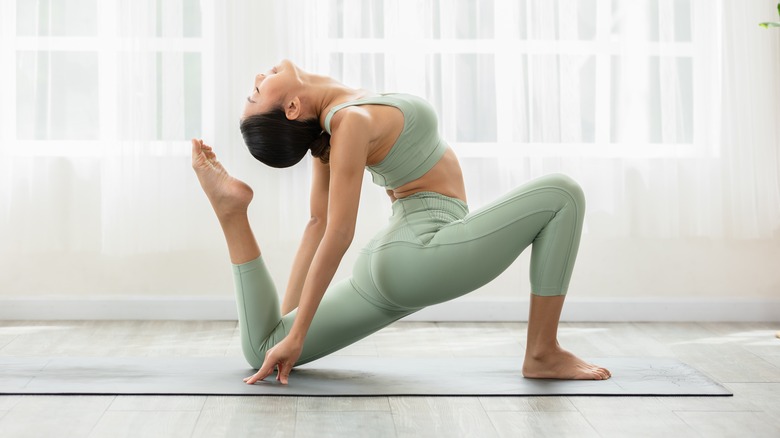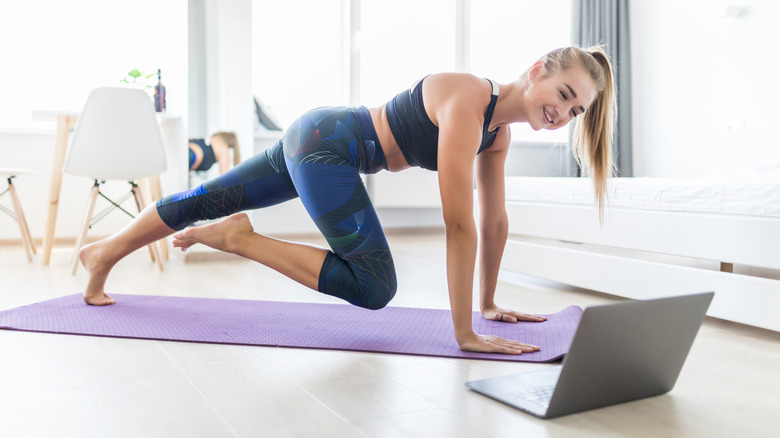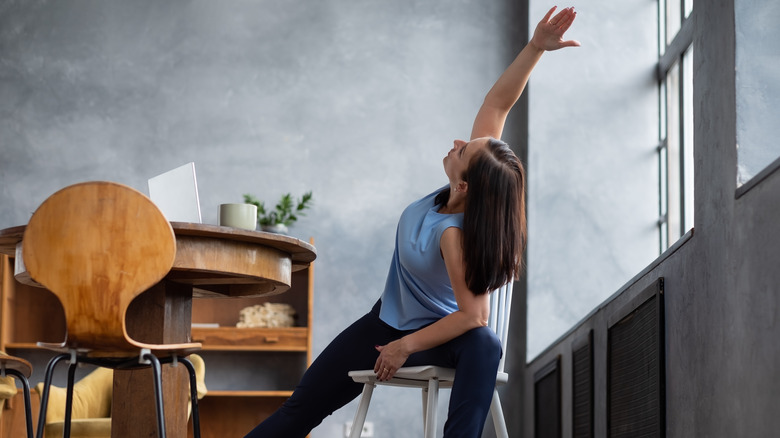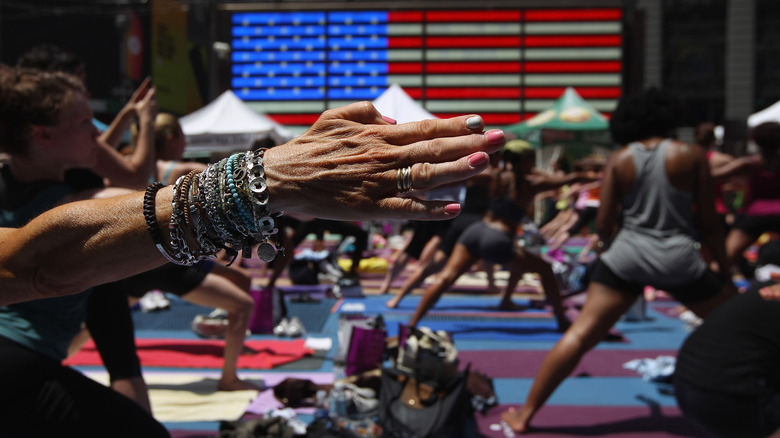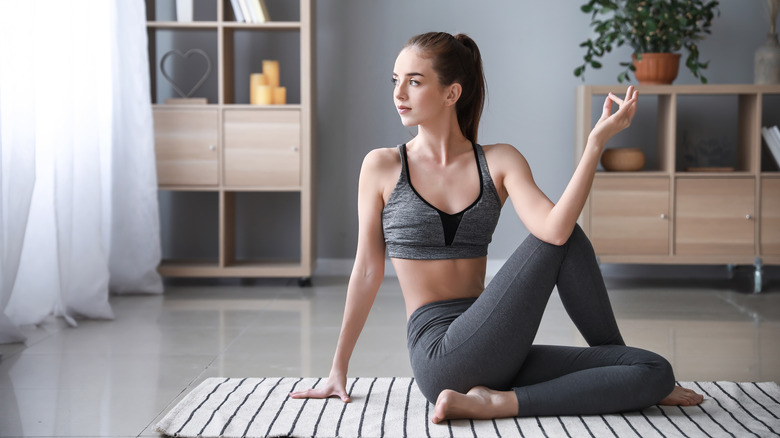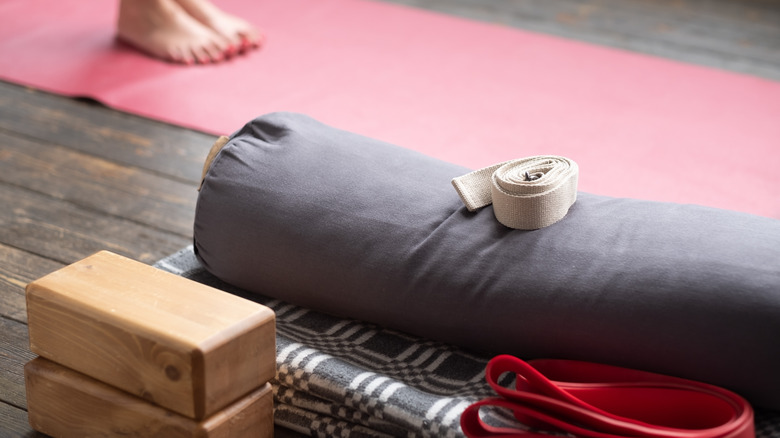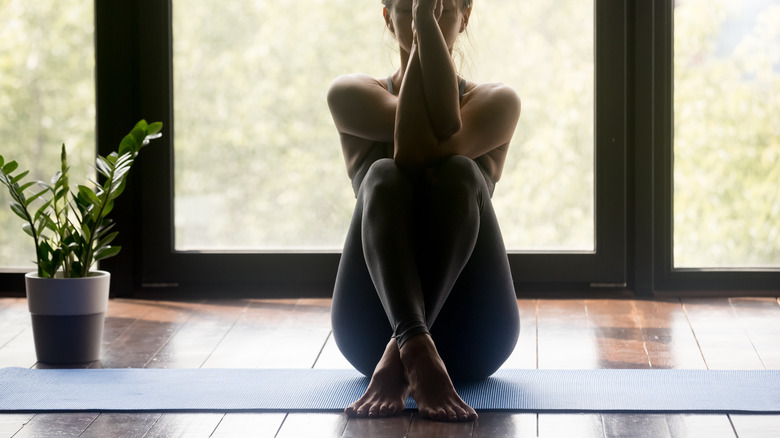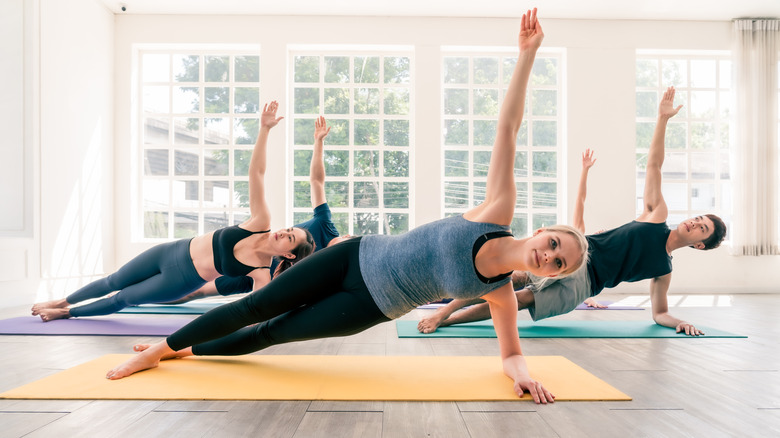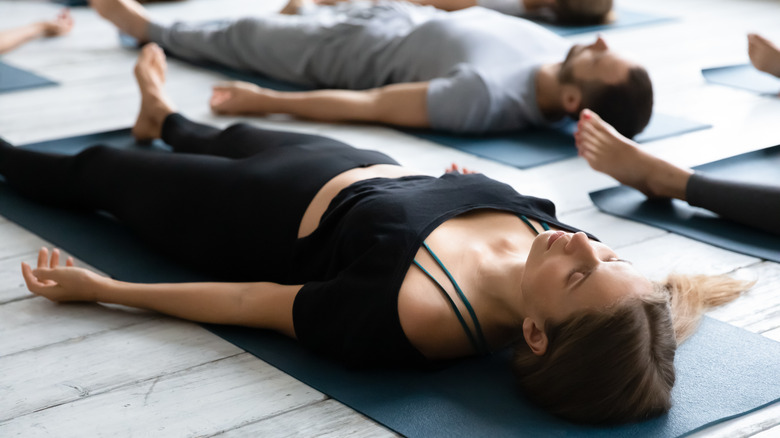How Long Should You Hold A Yoga Pose For The Best Results?
Yoga began as a spiritual practice in India thousands of years ago and forms one of the main pillars of Buddhism and Hinduism, but nowadays, it's an activity that's popular around the globe (via Google Arts and Culture). The art of yoga was first brought to the Americas in the late 1800s and quickly took off after a demonstration at the 1893 Chicago World's Fair as a new approach to life that incorporated positive thinking, proper exercise, healthy eating, deep breathing, and relaxation, per Yoga Journal. As the practice became more Westernized, however, it lost some of its original spiritual meaning in popular culture.
In the modern era, there is a variety of different approaches to yoga, with some leaning more into the workout sphere and emphasizing the art's physical benefits, and others focusing on spiritual aspects like meditation and deep breathing. Each of these styles serves a different purpose, so how long you should be holding each pose is dependent on your individual practice and final goals.
Power yoga
If you're looking for a yoga style that prioritizes fitness, power yoga might be the choice for you. According to Yoga Medicine, power yoga is a more fast-paced style that focuses on working the muscles as well as developing students' flexibility. This practice doesn't have many ties to the original spiritual purpose of yoga, but it's great if you find yourself frequently getting bored during slower, more regimented classes. The quick switches between poses will keep you engaged and prevent your mind from wandering.
The exact poses and pacing of a power yoga class depend on the instructor, but, for the most part, you'll only hold postures for a few breaths, quickly moving through sequences throughout the hour or hour and a half session. Some teachers even choose to combine this style with aspects of other types of yoga, upping the temperature of the room or bringing in slower sequences to increase the benefits and add some variety to the session.
Vinyasa
Vinyasa, or vinyasa flow, is one of the most common forms of yoga, and it focuses primarily on proper breathing techniques. In this practice, you link your movements with your breaths, breathing through each pose and moving almost rhythmically to the next. These classes are great if you want a lower impact, more mindful approach to your workouts, but you still want to focus on moving your body and increasing your flexibility and strength.
In this practice, everything is centered around your breath, and the hold times are no exception. Depending on the pose, it's common to hold anywhere from one to five breaths — a few seconds to a minute, roughly — before transitioning to the next one. Because there is such large emphasis on movement and flow, you don't spend much time sitting still in each posture, making this a great option if you don't want to feel stagnant but still prefer something relaxing.
Bikram
Bikram yoga, a form of hot yoga developed by Bikram Choudhury, is one of the more physical varieties of this practice. These classes cycle through 26 specific postures over an hour and a half, and have to follow a strict set of rules to be considered true Bikram yoga (via Yoga Medicine). Because of this, many instructors simply choose to call their classes hot yoga so they can have a bit more flexibility in their teachings, but a lot of the overall tenets remain the same.
Because these classes are so regimented, each pose has a specific hold time, ranging from a few seconds to about a minute and a half. This is one of the more fast-paced, exercise-focused forms of yoga, so coupled with the high temperatures in the room, you can expect to break quite a sweat. Your instructor will walk you through each pose and how long you should be holding it, but, because the class is the same set of movements each week, you will likely begin to learn the order and hold times as you continue your practice.
Hatha
Hatha yoga is a catch-all term that refers to balance in a practice. You may not have heard this specific terminology before, but if you've ever done a beginner yoga class, it was likely hatha yoga. According to Yoga Basics, these classes incorporate poses, meditation, and breathing exercises in one, so they're a great introduction if you haven't nailed down exactly which style you prefer yet.
Because hatha yoga classes are often introductory, poses tend to be held for a bit longer to develop students' patience and familiarity with the position. Getting into yoga after years of fast-paced HIIT workouts can be quite the transition, so even if students are physically fit, there's a mental learning curve. These classes provide a great opportunity to develop proper breathing techniques and practice mental clarity while still strengthening your body, and holding poses for a minute or longer can help you cultivate the patience and persistence needed to further develop your personal practice. If that seems too daunting, you can start with 30 seconds per pose.
Iyengar
Iyengar is one of the more classical forms of yoga that focuses on perfect alignment in poses, but its most well-known characteristic is its frequent use of props. Straps, bolsters, blocks, and chairs may feature in your Iyengar classes alongside the typical mats and water bottles as a way to support and correct different poses.
Because this practice is based more on technique and alignment, each pose is held for longer than it would be in a typical class, often between one and five minutes (via Yoga Rove). Instructors require large amounts of training to teach Iyengar yoga, so they may come around and make slight adjustments to your postures to ensure you're holding the perfect position. Despite the experience required to teach, these classes are actually recommended for people of all skill levels, especially those working through physical limitations, because the props can work to slightly modify poses while you increase your strength and flexibility.
Yin
Yin yoga, like Iyengar, focuses more on positioning than movement and breathwork. It also sometimes involves the use of props, but unlike Iyengar, it's focused more on the body's connective tissues rather than its muscles, and draws inspiration from the martial arts. This practice is great if you're doing other kinds of workouts or have a physical job and need to stretch and release tension after a high-intensity day. The primary areas of focus include the thighs, hips, and lower back, so this can even be beneficial for those with office jobs that find that their position at the desk leaves them feeling sore and stiff.
Because this practice is focused on specific techniques, poses are typically held longer than other practices, usually about three to five minutes per position. This gives your body enough time to sink into the pose and allows you to feel the benefits in your connective tissue, so you're sure to leave class feeling loose and relaxed.
Ashtanga
Ashtanga yoga combines both the spiritual and physical aspects of traditional yoga into one highly regimented practice. These classes flow through a series of six poses that have been recommended by the instructor. Once they decide a student has mastered a pose, after providing hands-on adjustments and observing each person in the class individually, the teacher will introduce another pose. Because of this, each student's practice is unique and paced specifically around them.
This highly customized practice also means that you should practice hold times that feel good for you. For the most part, these poses are held for five breaths, or around a minute, to allow you to relax into position and familiarize your body, but this can go on longer if you need further adjustments to get into the proper pose. This style emphasizes both flow and technique, so you will do a fair amount of moving around throughout the class, but it's not as quick as something like vinyasa.
Restorative
Instead of pushing your boundaries and encouraging you to step out of your comfort zone with new poses, restorative yoga seeks to actually remove unnecessary stimuli and encourages you to look within. In these classes, you go through a series of simple, static poses and meditations that encourage you to relax and release the stresses of the day. It's not uncommon to see students nodding off or hovering between being awake and asleep — much different from something like vinyasa or power yoga.
In restorative yoga, the focus is on breathing, meditation, and relaxation, so poses are often held for upwards of 10 minutes (sometimes up to 20) as the instructor leads a breathing exercise or encourages their class to sit quietly and resist the urge to move or fidget. These classes do still feature a bit of stretching, but for the most part, they're more similar to a group meditation — perfect if you want to practice mindfulness but you're not sure where to start.
